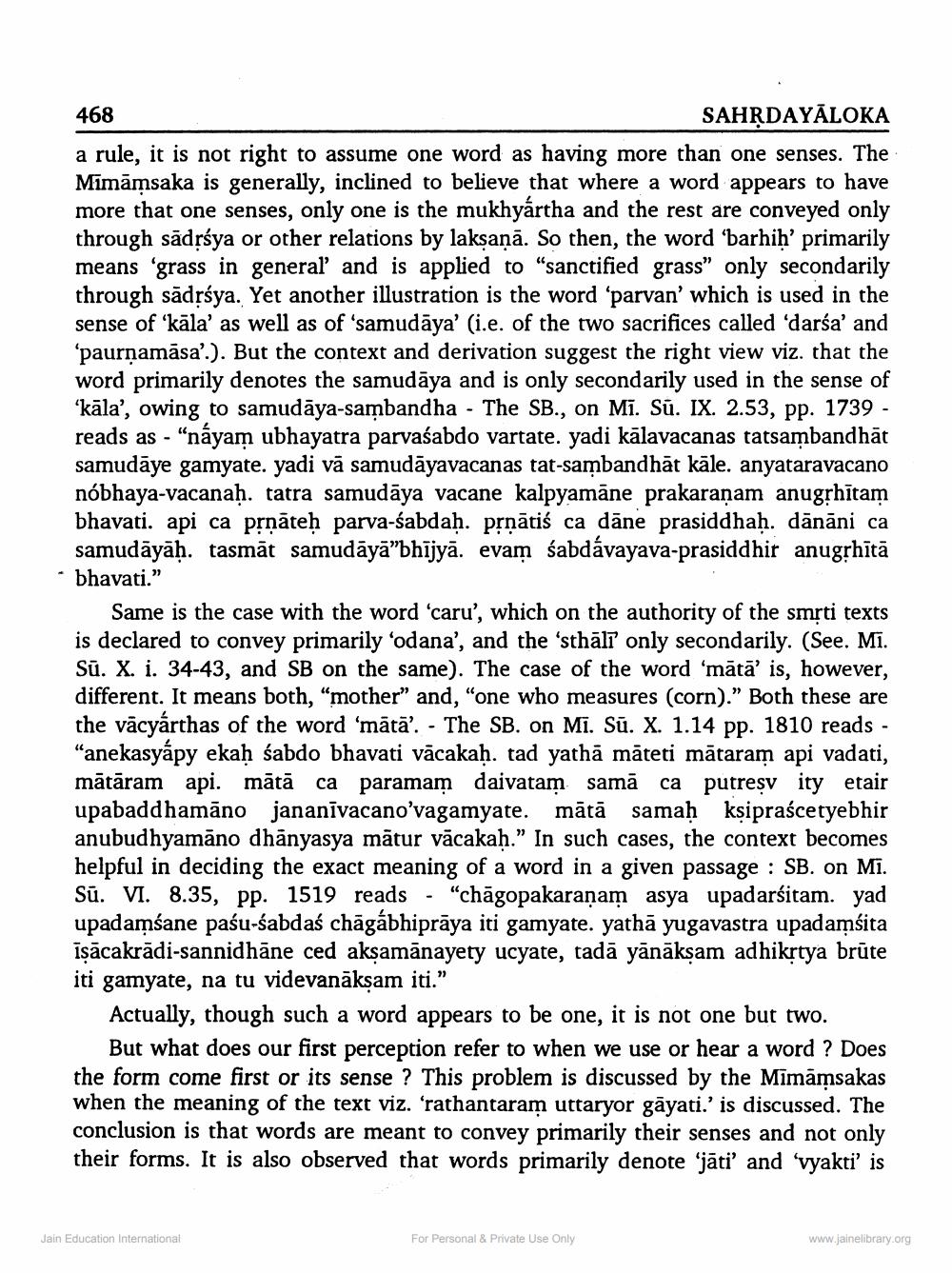________________
468
SAHRDAYĀLOKA
a rule, it is not right to assume one word as having more than one senses. The Mimāmsaka is generally, inclined to believe that where a word appears to have more that one senses, only one is the mukhyartha and the rest are conveyed only through sādrsya or other relations by laksanā. So then, the word 'barhih' primarily means 'grass in general and is applied to "sanctified grass” only secondarily through sādrsya. Yet another illustration is the word 'parvan' which is used in the sense of 'kāla' as well as of 'samudāya' (i.e. of the two sacrifices called 'darśa' and 'paurnamāsa'.). But the context and derivation suggest the right view viz. that the word primarily denotes the samudāya and is only secondarily used in the sense of kāla', owing to samudāya-sambandha - The SB., on Mi. Sū. IX. 2.53, pp. 1739 - reads as - "náyam ubhayatra parvaśabdo vartate. yadi kālavacanas tatsambandhāt samudaye gamyate. yadi vā samudāyavacanas tat-sambandhāt kāle. anyataravacano nóbhaya-vacanaḥ. tatra samudāya vacane kalpyamāne prakaranam anugrhītam bhavati. api ca prnāteh parva-sabdah. prnātiś ca dāne prasiddhah. dānāni ca samudāyāḥ. tasmāt samudāyā”bhījyā. evam śabdávayava-prasiddhir anugrhītā bhavati.”
Same is the case with the word 'caru', which on the authority of the smrti texts is declared to convey primarily 'odana', and the 'sthālī only secondarily. (See. Mi. Sū. X. i. 34-43, and SB on the same). The case of the word 'mātā' is, however, different. It means both, “mother” and, “one who measures (corn).” Both these are the vācyárthas of the word 'mātā'. - The SB. on Mi. Sū. X. 1.14 pp. 1810 reads - "anekasyápy ekah sabdo bhavati vācakah. tad yathā māteti mātaram api vadati, mātāram api. ātāca paramam daivatam samā ca putreşvity etair upabaddhamāno jananīvacano'vagamyate. mātā samah ksiprascetyebhir anubudhyamāno dhānyasya mātur vācakaḥ." In such cases, the context becomes helpful in deciding the exact meaning of a word in a given passage : SB. on Mi. Sū. VI. 8.35, pp. 1519 reads - "chāgopakaranam asya upadarśitam. yad upadamśane paśu-sabdaś chāgábhiprāya iti gamyate. yathā yugavastra upadamsita īsācakrādi-sannidhāne ced akşamānayety ucyate, tadā yānākşam adhikrtya brūte iti gamyate, na tu videvanākşam iti."
Actually, though such a word appears to be one, it is not one but two.
But what does our first perception refer to when we use or hear a word ? Does the form come first or its sense ? This problem is discussed by the Mimamsakas when the meaning of the text viz. 'rathantaram uttaryor gāyati.' is discussed. The conclusion is that words are meant to convey primarily their senses and not only their forms. It is also observed that words primarily denote 'jāti' and 'vyakti' is
Jain Education International
For Personal & Private Use Only
www.jainelibrary.org




